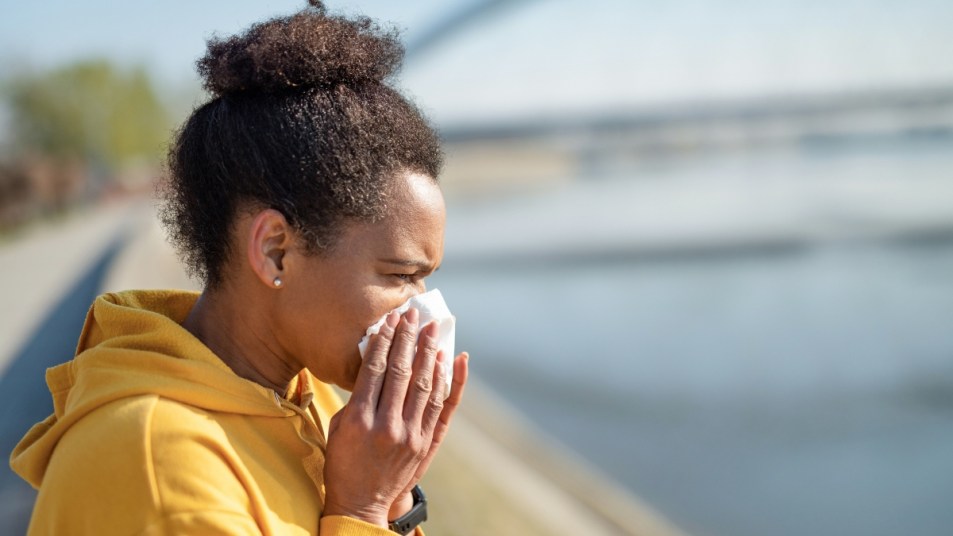How to Stay Active in the Fall Without Making Your Allergies Worse

You want to appreciate the beautiful fall foliage and get some exercise with an outdoor walk. You step outside in your sneakers and jacket, ready to breathe in the crisp, chilled air. There’s just one problem: You can’t stop sneezing! Fall allergies might be to blame.
Unfortunately, breathing heavily from exercise while you’re reacting to pollen and other allergens will make things even worse. It’s true that ragweed season peaks in mid-September, so the bulk of pollen tends to diminish as the season progresses. Still, ragweed and other allergens can float through the air well into October.
“Other weeds that also release their pollen during this time [are] goldenrod, curly dock, lamb’s quarters, pigweed, sheep sorrel, and sagebrush,” says Dr. Payel Gupta, MD, allergist and co-creator of Get Cleared. In other words, we’re not out of the woods with fall allergies just yet.
Other Fall Allergies That Make Exercise Difficult
It’s not just a high pollen count that’s giving you itchy ears and a sniffly nose. According to Dr. Gupta, leaves and hay may also cause an immune system reaction. “Leaves and hay can carry mold and other pollen which can induce symptoms,” she says.
Jumping in a pile of leaves and taking hay rides are beloved activities in the fall. But if those activities have made you sneeze, cough, and itch relentlessly, you may have a mold allergy. The Asthma and Allergy Foundation of America notes that the symptoms of a mold allergy mirror those of hay fever. If mold enters your lungs, it can trigger asthma, too. And while pollen dies with the first killing frost, molds don’t. They only become inactive in the winter.
Around this time of year, molds in your home can trigger allergies as well. “Mold, dust mites, pets and cockroaches are year-round allergens that can also affect people in the fall, especially as it gets colder and people spend more time indoors,” says Dr. Gupta. So, if you’ve been exercising in a room that smells a bit like mold or mildew, it’s definitely time to give it a deep cleaning.
How to Treat Your Allergies So You Can Keep Exercising
If you want to exercise without endless sneezing and itching, Dr. Gupta suggests treating your allergies first. “Keep windows shut so that pollen doesn’t enter your home,” she advises. “Make sure to wash your face and hands when coming in from the outside. Hair can also carry pollen, so if you’re having a particularly hard [allergy] day, make sure you wash your hair.”
If you’re still suffering after those tricks, it might be time to try some over-the-counter drugs. “Medications that are over the counter for allergies include oral antihistamines, steroid nasal sprays, [and] antihistamine eye drops,” she says. A nasal saline rinse, like a neti pot, may also help. However, Dr. Gupta says you must keep the bottle and system clean to prevent mold growth.
If all else fails, talk to your doctor. “Allergy shots and sublingual Immunotherapy tablets are a great way to help with allergies,” Dr. Gupta explains. “They are a long-term treatment plan and help to slowly reduce your allergies so that over time you don’t react to the allergens.”
How to Exercise Without Exacerbating Allergies
Though physical activity can aggravate fall allergies, there are still ways to get your exercise in each day. If you want to exercise outside, Dr. Gupta recommends watching the pollen count in your area, using sites like Klarify. “During high pollen counts, it might be wise to exercise indoors,” she says.
It might also be helpful to avoid the outdoors in the morning and early afternoon, when the pollen count rises. “Because pollen travels freely on warm, dry, windy days, pollen levels can often peak at the middle of the day,” Dr. Gupta explains.
The Mississippi Asthma and Allergy Clinic also suggests that you stay indoors if it’s dry or windy. Pollen travels greater distances in that type of weather. However, exercising right after it rains or in the evening can help reduce symptoms. These tend to be times when fewer allergens are floating through the air.
If you’re exercising indoors, make sure you have a clean space. Dust the room regularly. Wipe down the walls and thoroughly vacuum any rugs or carpets. Test the walls for mold by dabbing a swab of diluted bleach on the wall. If the spot lightens quickly, you may very well have mildew or mold. Clean it off with a mixture of one part bleach, three parts water.
Above all, remember to listen to your body. If you’re feeling way too tired or aggravated from allergies, take a rest day. Pushing through a workout when you’re not at your best could make things worse, not better.












